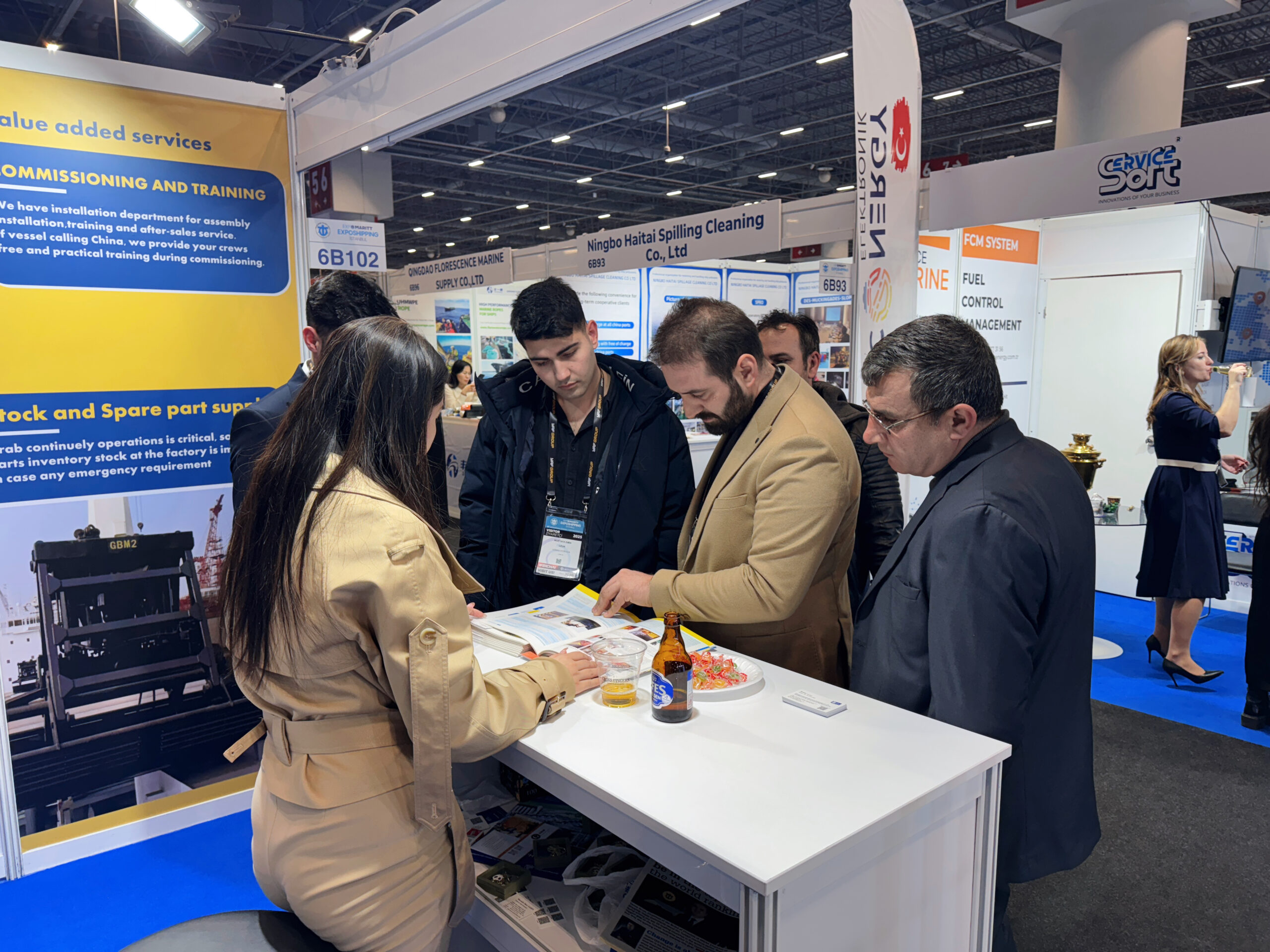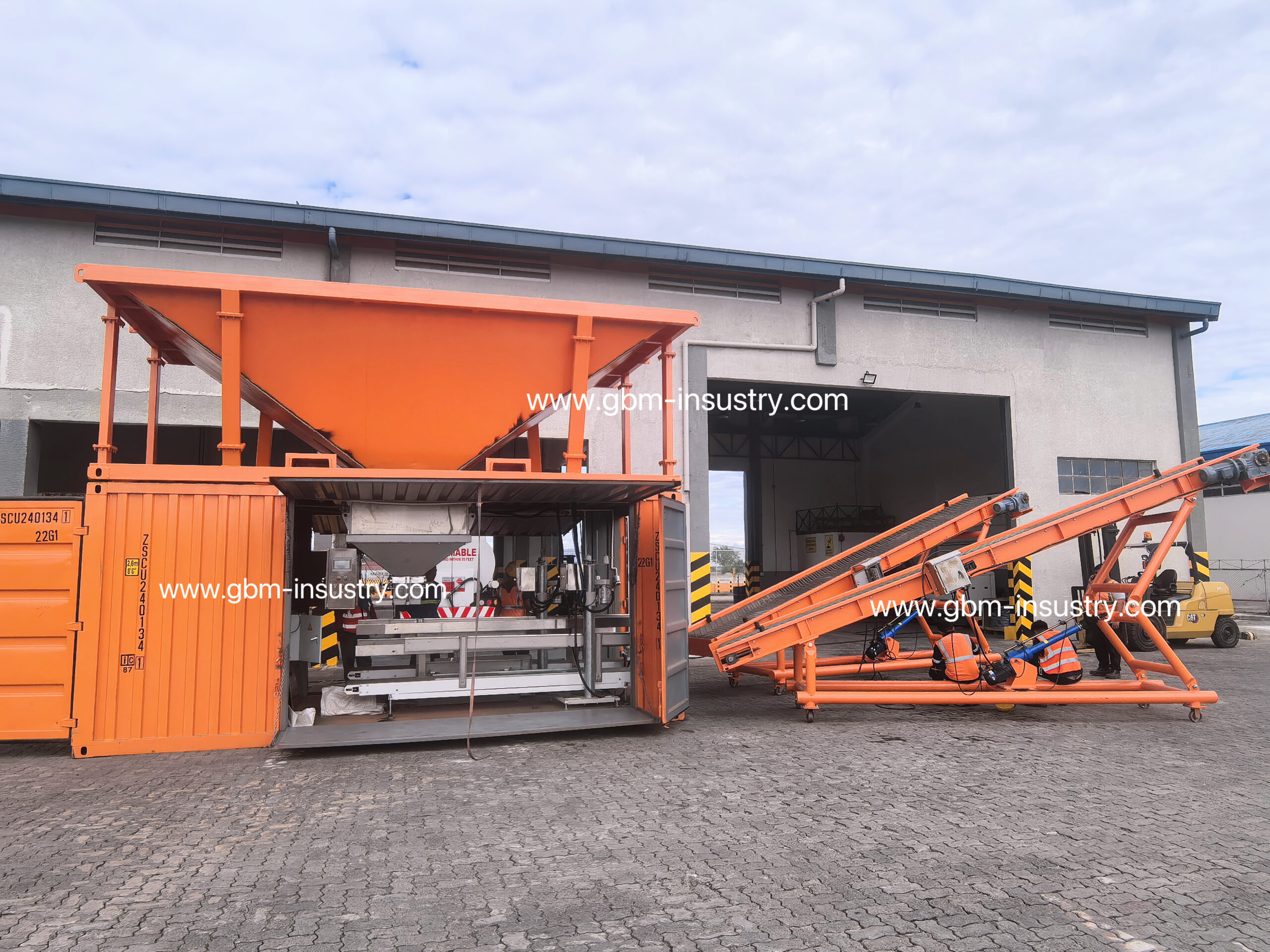Main principles and types of dust collection systems and their application in bulk cargo hoppers
In the busy operations of modern bulk terminals, huge ships unload cargo, conveyor belts run at high speeds, and trucks shuttle back and forth, inevitably causing dust pollution. Dust generated during the loading, unloading, transfer, and storage of bulk materials such as coal, ore, grain, and fertilizer not only threatens environmental quality and human health, but also accelerates equipment wear and causes material loss. As the key line of defense against dust pollution, dust collection systems have become an indispensable part of modern, green bulk terminals. This article will explore the basic principles and mainstream types of dust collection systems, with a focus on innovative applications in bulk hoppers, especially mobile bulk hoppers.
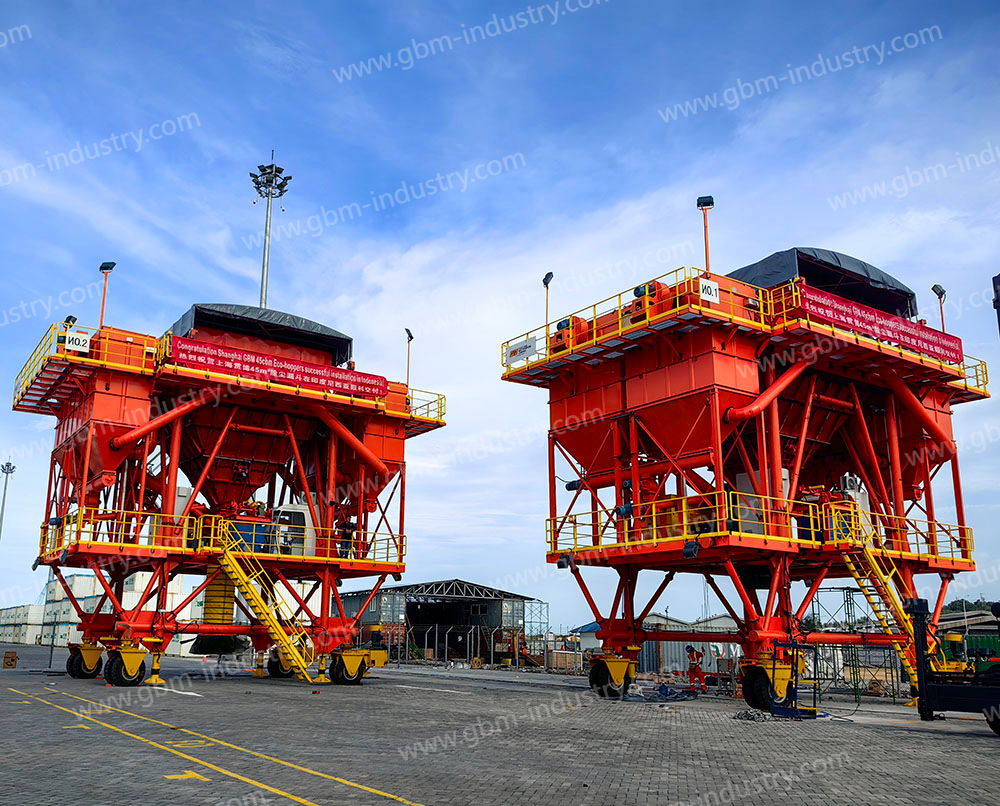
What is a dust collection system?
A dust collection system refers to a set of equipment and technologies that use physical, chemical or mechanical methods to capture, separate, suppress or remove suspended dust particles in the air.In bulk terminal operations, the goal is to control the dust concentration generated at key material transfer points (such as ship unloader discharge points, belt conveyor transfer points, stacker-reclaimer working surfaces, truck/ship chutes, bulk hoppers, etc.) within the limits set by international and domestic environmental protection regulations and occupational health and safety standards.
The necessity of dust collection systems in bulk terminal operations
Environmental compliance:
The International Maritime Organization (IMO), the International Association of Ports and Harbors (IAPH) and various national governments (e.g. China’s Air Pollution Prevention and Control Law and Port Engineering Environmental Protection Design Code JTS 149-1) have set increasingly stringent standards for unorganized dust emissions from ports. Excessive emissions will result in heavy fines, operational restrictions and even the risk of shutdown, making dust collection systems a mandatory requirement for compliant operations.
Occupational health and safety:
Bulk cargo dust (especially coal, silica sand, and ore dust) is rich in inhalable particulate matter (PM10, PM2.5) and harmful substances (such as free silica and heavy metals). Long-term exposure can cause serious occupational diseases such as silicosis, pneumoconiosis, and chronic respiratory diseases, threatening the health of dock workers and surrounding residents. Effective dust collection is central to protecting workers’ rights and social responsibility.
Equipment Maintenance Costs:
Dust infiltration into mechanical equipment (such as conveyor belt bearings, rollers, motors, electrical cabinets, and hydraulic systems) accelerates wear, corrosion, and short circuits, significantly reducing equipment lifespan, increasing failure rates, and raising maintenance costs. Statistics show that in dusty environments, the failure rate of critical equipment can increase by over 200%, with maintenance costs rising by 30–50%.
Material loss and economic efficiency:
In open-air stockyards or during transportation, dust loss caused by wind is significant, especially for lightweight, dry materials (such as coal powder and grain). The annual material loss rate can reach 0.3%-0.8%, which translates to thousands or even tens of thousands of tons of economic loss for ports with massive annual throughput. Effective dust suppression directly equates to cost savings.
Core considerations for the use of dust collection systems in bulk terminal equipment
Material characteristics:
- Particle size distribution: Fine powders (such as cement and fly ash) are more prone to dust than coarse particles (such as lump coal and large ore pieces) and require more efficient dust collection.
- Density and fluidity: Material density affects the settling speed; fluidity affects the degree of dust generated by falling impact.
- Humidity: Materials with low water content (<5%) (such as dry iron ore powder) are extremely prone to dust generation; materials with high humidity may adhere to equipment.
- Abrasiveness: Dust from high-hardness materials such as ore and clinker causes severe wear on dust collection equipment (such as pipes and filter materials).
- Explosiveness: Grain, sulphur, and certain types of coal dust are explosive, so dust collection systems must meet explosion-proof requirements.
- Hydrophilicity/hydrophobicity: Affects the effectiveness of wet dust suppression (e.g., spraying, dry fog).
Operating scenarios:
- Open-air vs. enclosed: Open-air storage yards are greatly affected by wind and require more powerful or wider coverage dust suppression (such as windbreak nets + intelligent spraying); enclosed transfer stations can implement closed exhaust dust removal.
- Operating frequency and intensity: Continuous high-intensity work sites require stable and reliable dust removal equipment.
- Weather conditions: Wind speed, wind direction, temperature (frost protection in northern winters) and humidity are important factors.
System compatibility:
- Dust collection equipment must be seamlessly integrated with existing loading and unloading processes (unloaders, loaders, stackers and reclaimers), conveying equipment (belt conveyors) and transfer equipment (hoppers) in terms of spatial layout, power supply and control logic.
- For mobile equipment (such as mobile hoppers and ship loaders), restrictions on mobility, flexibility and energy supply (hydraulic, electric) must be considered.
Dry dust collection systems
Physical methods (filtration, inertial separation, electrostatic adsorption) are used to separate and collect dust without changing its physical state.
Bag filter
Bag filter principle:
Dusty air flows through filter bags made of fibrous fabric. Dust particles are trapped on the outer surface of the filter bag or in the gaps between the fibers, and clean air passes through the filter bag and is discharged. As the dust layer thickens, the resistance increases, and it is necessary to periodically clean the dust by means of compressed air pulse back blowing, mechanical vibration or back blowing, so that the dust falls into the lower ash hopper.
Advantages of bag filters:
- High dust-collecting efficiency: The collection efficiency of fine dust (including PM2.5) is usually >99.9%, and the emission concentration can be stably maintained below 10mg/m³.
- High adaptability: Can handle dust of different particle sizes and properties (appropriate filter material must be selected).
- Large air handling capacity: Can meet large air volume requirements by increasing the number or size of filter bags.
- Collected dust can be recycled: The collected dry powder is easy to recycle (e.g., return to the process or sale).
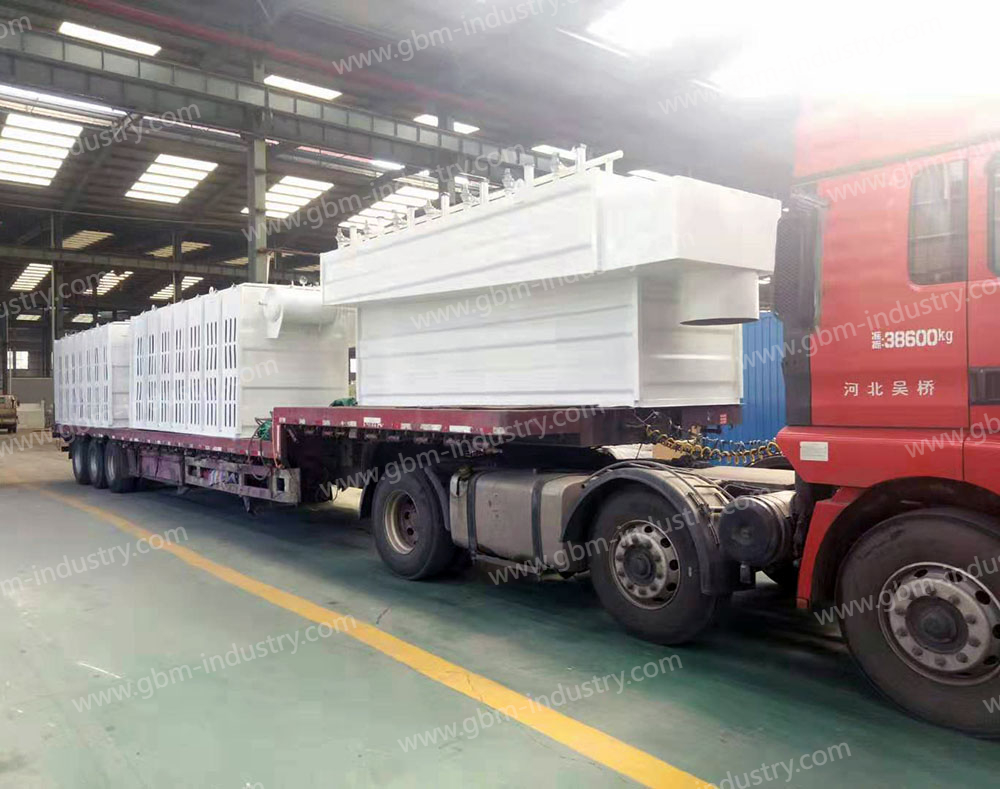
Cyclone dust collection system
Cyclone dust collection system principle:
The dust-laden airflow enters the cylindrical-conical cylinder at high speed along the tangential direction, forming a strong rotational movement inside. Under the action of centrifugal force, the dust particles are thrown towards the cylinder wall, collide with the wall surface and lose their kinetic energy, sliding down the wall surface to the bottom ash hopper. The purified gas is discharged from the top centre pipe.
Advantages of cyclone dust collection systems:
- Simple structure and low cost: No moving parts, easy to manufacture, install, and maintain.
- Stable and reliable operation with low maintenance costs: Resistant to high temperatures, high pressure, and wear (can be lined with wear-resistant materials).
- No consumables: Operating costs are primarily energy-related.
- Suitable for primary treatment of large particles and high dust concentrations: High efficiency for particles >10 μm.
Wet dust suppression technology
Captures dust particles using water or other liquid media, causing them to gain weight, agglomerate, and settle.
Spray dust suppression
Spray dust suppression principle:
Ordinary nozzles atomize water into droplets with relatively large particle sizes (100–500 μm) and spray them onto dust-generating points or material surfaces. The droplets capture dust particles through collision, interception, diffusion, and coalescence, causing them to become heavier and settle.
Advantages of spray dust suppression:
- Simple system, low investment cost: Mainly consists of a water pump, pipes, valves, and nozzles.
- Quick installation and wide coverage: Suitable for fixed or mobile spraying in large-area stockyards and open-air material piles.
- Simple operation and maintenance.
Dry fog dust suppression
Dry fog dust suppression principle:
Using a two-fluid nozzle or ultrasonic atomizer that combines compressed air and water, extremely small (typically 1–50 μm) ‘dry fog’ particles are generated. These micro-droplets are similar in size to dust particles and, through Brownian motion, diffusion effects, and inertial collisions, efficiently collide with, wet, and agglomerate dust particles, forming aggregates that accelerate their settling. The droplets are small and evaporate quickly, leaving the material surface ‘wet but not wet.’
Advantages of dry fog dust suppression:
- High dust suppression efficiency: Suppression efficiency for respirable dust (PM10, PM2.5) can exceed 90%.
- Extremely low water consumption: Compared to traditional spraying systems, water usage can be reduced by 70%-90%, with approximately 0.1-0.3 litres of water per tonne of material, preventing excessive moisture on the material.
- Wide applicability: It is especially suitable for enclosed or semi-enclosed spaces (such as hoppers, feed chutes, transfer stations), and is also suitable for local dust suppression in open spaces.
- Does not affect material properties: It does not cause material caking, freezing (frost protection is required in winter) or affect subsequent processes.
Integrated dust-collecting solution for mobile bulk cargo hoppers
Mobile bulk cargo hoppers are widely used at the front of docks, storage yards and loading points due to their high flexibility and adaptability. However, their mobility also poses a huge challenge for the integration of dust collection systems: limited space, difficult sealing and unstable energy supply. Customised design is required for different material characteristics:
Dust collection hopper design for coal and coke materials (mainly using dry mist)
Implementation Method:
Install a ring-shaped dry mist dust suppression ring at the upper part of the hopper cone (material impact zone), with densely arranged dual-fluid nozzles.
Install flexible dust curtains/sealing skirts at the edges of the material receiving opening to reduce dust leakage.
Consider adding buffer grilles/deflector plates above the material flow to reduce material falling speed and impact-induced dust generation.
The control system is linked to material flow detection (such as radar and photoelectric sensors) to achieve intelligent control that starts and stops misting when material is present or absent.
Comprehensive considerations and technical difficulties:
Coal (especially pulverised coal) has good fluidity and causes severe impact dust.
Coke is hard, has many sharp edges and corners, and has a high impact force.
The space is small, so a compact dry mist generator (often integrated into the hopper support) must be designed.
The connection of water and air sources during movement must be reliable (e.g., using quick connectors and reels).
Advantages of the solution:
Effectively suppresses PM2.5/PM10-level dust with remarkable results.
Extremely low water consumption, with virtually no impact on coal heat output.
The system is relatively simple, easy to maintain, and highly adaptable to space constraints.
Moderate investment and operating costs.
Dust-collecting hopper for iron ore (using closed exhaust + bag dust collector)
Implementation Method:
The receiving area of the mobile hopper is designed as a relatively closed cover (top and sides).
Ventilation openings are opened at the top or sides of the cover and connected to wear-resistant air ducts.
Equipped with a compact mobile bag dust collector (usually placed behind or on the side platform of the hopper). The dust collector needs to consider a cyclone pre-separator to first remove large particles and highly abrasive dust to protect the filter bag.
The dust collected in the dust collector hopper can be designed to return to the main material flow or be collected centrally.
Heavy-duty wear-resistant rubber curtains or automatic lifting sealing devices should be used at the openings of the enclosure (such as vehicle receiving ports).
Comprehensive consideration and technical difficulties:
Iron ore dust is dense and highly abrasive, causing severe wear on pipes, valves and filter bags (wear-resistant linings, ceramic coatings and wear-resistant filter bags are required).
The required air volume is large, and the fan power and dust collector volume need to be optimised to suit the load capacity and space of the mobile equipment.
The structural strength and wear resistance of the sealed cover are high.
The flexible connection and sealing of the air duct during movement is a difficult point.
The energy supply (electricity for high-power fans) needs to be reliably solved (e.g. towing cable reels, large-capacity vehicle-mounted batteries).
Advantages of the solution:
Highest dust collection efficiency (>99.9%), effectively capturing highly abrasive fine ore dust.
The collected ore powder can be recycled, reducing material loss.
The system is less affected by external environmental factors (wind).
Dust collection hopper design for grain (mainly using negative pressure dust collection)
Implementation Method:
Install a dust collection hood above or to the side of the hopper inlet.
Connect an explosion-proof fan and an explosion-proof filter cartridge dust collector (the filter cartridge material must be antistatic and flame retardant).
The dust collector body is designed with a blast vent or explosion suppression valve.
The entire system (hopper, dust collection hood, air duct, dust collector) must be reliably grounded to eliminate static electricity.
Filter cartridge dust collectors are preferred because they are more compact, easier to install on mobile equipment, and have better dust removal performance.
Comprehensive considerations and technical difficulties:
Grain dust (wheat, corn, soybean flour, etc.) is highly flammable and explosive (high Kst value for dust cloud explosion index). Explosion-proof design is a top priority.
Dust is light and easily suspended, requiring a certain wind speed for capture.
The dust collection hood design should not interfere with loading and unloading operations or vehicle access.
Explosion-proof electrical components and reliable grounding should be implemented for mobile equipment.
Advantages of the solution:
Effectively controls dust dispersion and meets strict hygiene and safety (explosion-proof) requirements.
Filter cartridge dust collectors are more compact than bag filters and are suitable for mobile equipment with limited space.
The collected grain dust (when the grade allows) can be considered for recycling.
Dust-collecting hopper design for fertilizers (using micro-mist humidification + local enclosure)
Implementation Method:
Fine spray or micro-mist nozzles are installed at the material drop point and hopper outlet area for humidification and dust suppression.
Combined with local lightweight dust curtains/enclosures to reduce the dust diffusion range.
For fertilizers prone to moisture absorption and caking (e.g., ammonium nitrate, certain compound fertilisers), precise control of humidification levels (micro-mist is preferable) is required. Compressed air air curtains or heating devices can be installed near the nozzles to prevent nozzle blockage and condensation of moisture in critical areas.
The inner walls of the hopper are lined with smooth, non-stick materials (e.g., ultra-high molecular weight polyethylene) to reduce material adhesion and facilitate cleaning.
Design convenient cleaning and maintenance ports.
Comprehensive consideration and technical difficulties:
Fertilizer dust is generally hygroscopic and corrosive, which can easily cause equipment rust and blockages.
Excessive humidification can cause material agglomeration and caking, affecting flowability and product quality.
Select suitable corrosion-resistant nozzles and pipe materials (such as stainless steel and engineering plastics).
Precise control of the humidification amount is the key to the technology.
Advantages of the solution:
Effectively suppresses dust flying and prevents excessive moisture and caking of materials.
The system is relatively simple, low in cost, and easy to implement on mobile hoppers.
Minimizes the impact on the physical properties of fertilizers.
Dust collection hopper design for cement clinker (using bag dust collection or cyclone dust collection)
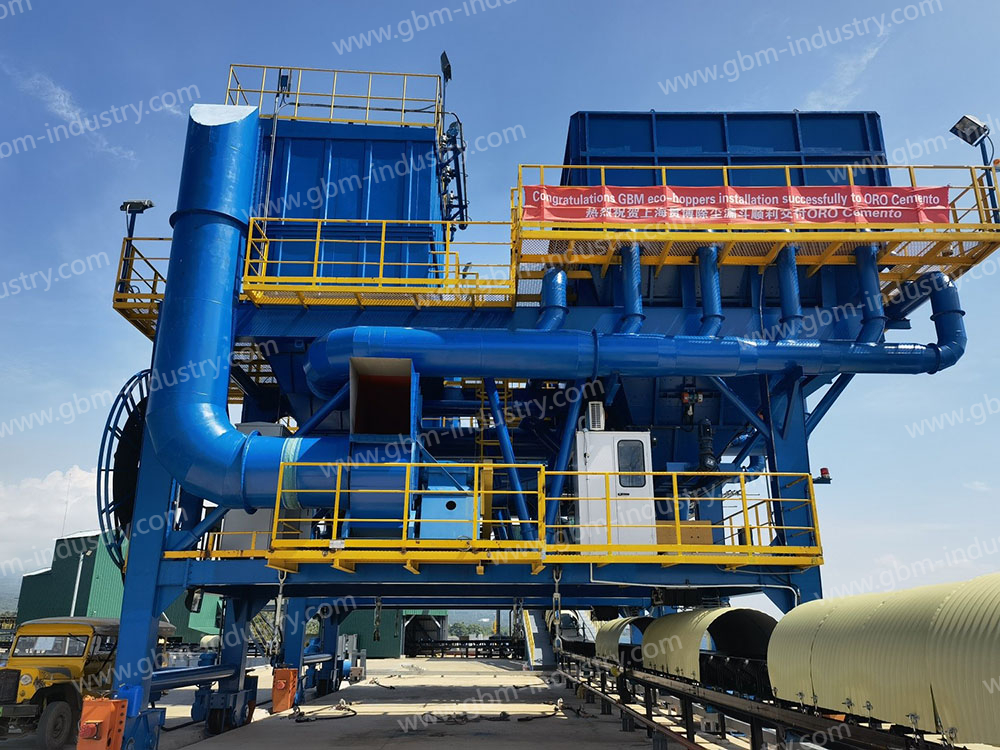
Implementation Method:
Solution 1 (bag dust collector): Similar to the iron ore solution, a sealed cover + wear-resistant bag dust collector (with cyclone pre-separation) is used. Suitable for applications with extremely high emission requirements, fine dust and large quantities.
Solution 2 (cyclone dust collector): One or more high-efficiency cyclones are integrated into the mobile hopper body. The dust-laden airflow enters tangentially from the top, and the dust is separated and falls into the lower ash hopper or returns directly to the material flow, while the clean air is discharged from the top. The structure is simpler and more compact.
A simple wet washing process (spraying a small amount of water mist) can be considered as a secondary treatment after cyclone dust collection to further improve efficiency (drainage and sludge treatment must be considered).
All components in contact with high-temperature clinker must be heat-resistant.
Comprehensive consideration and technical difficulties:
If cloth bags are used for dust removal, high-temperature and high-wear-resistant filter materials (such as glass fibre membrane, P84) must be selected, and the high-temperature flue gas must be cooled appropriately (such as mixed air) first. The cyclone dust collector needs to be lined with wear-resistant ceramics.
Clamber dust particles are relatively coarse, and cyclone dust removal has a certain efficiency (>80%), but fine powder collection is insufficient.
Space and load restrictions on mobile equipment have a significant impact on the selection of dust collectors.
Advantages of the solution:
Cloth bag solution: Highest efficiency, meets strict emission standards, and high dust recovery value.
Cyclone solution: Extremely simple and reliable structure, no consumables, extremely low maintenance costs, good high temperature and wear resistance, low investment, particularly suitable for mobile hoppers with limited space and load restrictions and applications with relatively relaxed fine dust emission requirements.
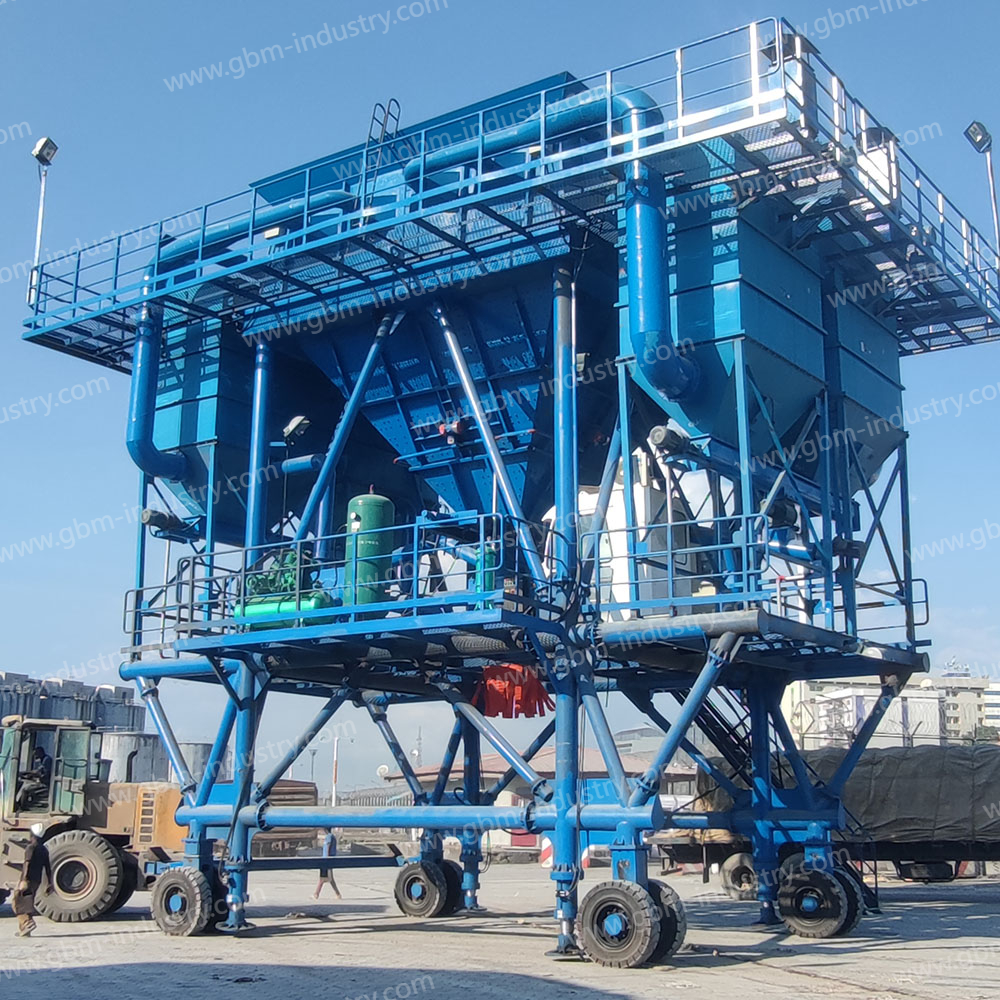
Summary
Dust collection systems are not optional accessories for bulk terminals, but core equipment for ensuring green, safe, efficient and sustainable terminal operations. They are ‘green guardians’ that protect blue skies and the health of workers. From high-efficiency bag filters and simple cyclone separators to water-saving dry mist dust suppression and wide-coverage spray systems, a variety of technologies provide powerful tools for addressing dust challenges posed by different material characteristics and operating scenarios.
GBM has integrated dust collection systems into mobile bulk cargo hoppers, facing severe challenges in terms of space, sealing, mobility, and energy supply. However, through targeted innovative designs (such as modular dust collection units, flexible seals, wear-resistant inner linings, and explosion-proof designs), it has successfully achieved the perfect integration of ‘dust suppression’ and ‘efficient loading and unloading. Whether it is dry mist rings for coal and coke, enclosed ventilation for iron ore, explosion-proof negative pressure systems for grain, precise micro-mist systems for fertilizers, or wear-resistant cyclone/baghouse systems for cement clinker, these solutions embody the core principle of technology serving specific needs. These integrated solutions significantly reduce dust concentrations at operational points, minimize material loss, extend equipment lifespan, and fundamentally ensure the occupational health of employees and the compliant operation of terminals.



